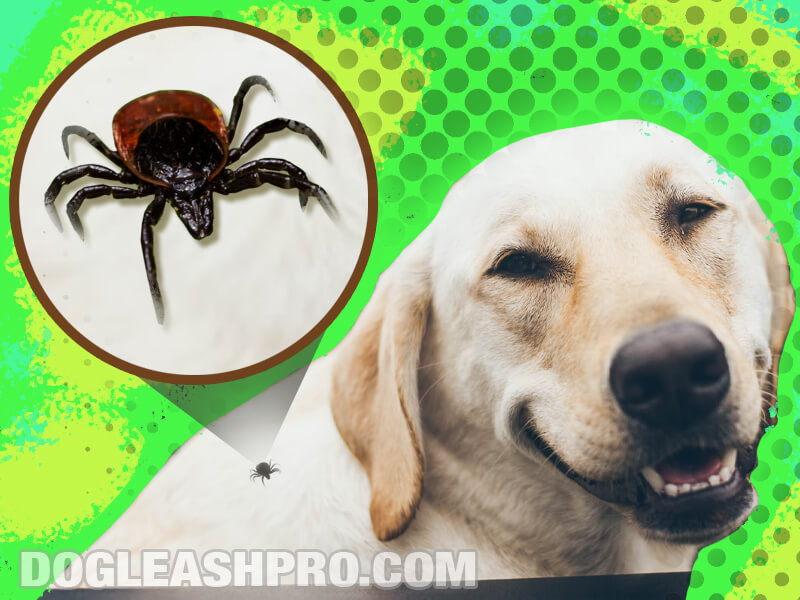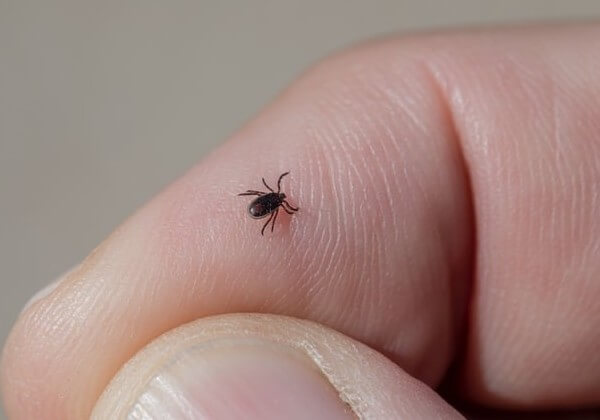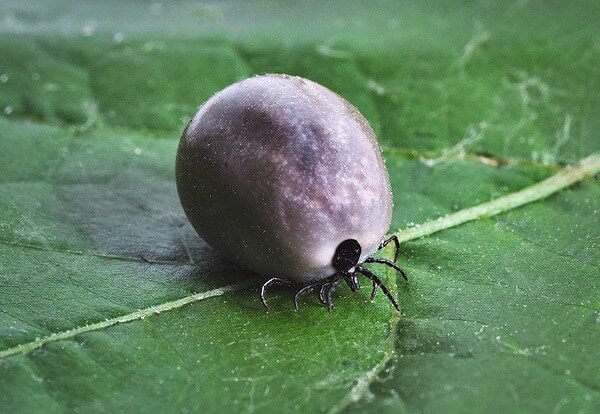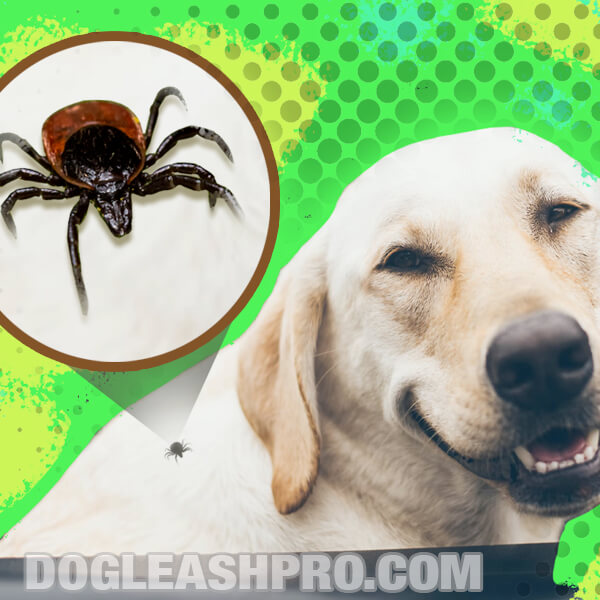
Every spring and fall season, I’d find both dried dead ticks and engorged ticks on my dogs’ skin. Both my dogs love to curl up on my lap for some nice belly rubs after a long walk. All of a sudden, I feel several bumps not only on their bellies, but also on their necks, mouths, heads, and noses.
As I parted their fur to see what these bumps were, I was horrified and disgusted. There were a few dried dead ticks buried on my dogs’ skin. Although very startling to find dried dead tick on dogs, this is actually very common.
If you’re in the same situation, you may also be wondering what you should do next. Should you be worried or concerned?
Fortunately, dried dead ticks found on your dogs are surprisingly less dangerous than live ticks. Let’s discuss this further next.
Table of Contents
Dried Dead Tick On Dog is less dangerous than live Tick

If you notice the ticks on your dog’s skin are dead, then you’ll be glad to know that there’s little to no chance that this dried dead tick will be able to transmit illnesses like Lyme disease to your canine friends.
That’s because ticks usually need to stay and feed on your dog’s skin for up to 24 hours before they’re able to transmit the bad bacteria from their stomach into your canine friend’s bloodstream.
Thus, it’s not possible for dogs to get sick if the ticks were on their skin for only a few hours or less than 24 hours.
However, like live engorged ticks, the dried dead tick on dog should still be removed promptly and carefully. Keep reading because we will discuss how to remove a deeply embedded tick from a dog below.
Some may say that ticks only come out in warmer months like spring or summer months and this is partially true. Some tick species are most active during the summer and spring months. However, there are other tick species that are active all year round.
For instance, deer ticks (or adult black-legged ticks, which are known to carry Lyme disease) become active right after the first frost from fall to spring season.
Therefore, our furry friends may also get dried dead ticks on them during the winter months depending on where you live.
You may be interested in: White Spot On Dog’s Nose – What Does It Mean?
Will a Dead Tick fall off the dog’s skin?

When you see dead ticks embedded in your dog’s skin, head, nose, mouth, neck, or belly, you’ll want to remove them as soon as you can. Avoid leaving the dead ticks embedded in your dog’s skin because of the following reasons:
- Dead ticks left on your furry friend’s skin can cause red and inflamed skin.
- The dog’s skin with the dead ticks can become irritated.
- Purposely leaving the dead ticks on your dog’s skin is an eye-sore.
How to remove embedded Tick from dog?

To remove the embedded dried dead tick from your dog’s skin, you’ll want to use a sharp tweezer. The sharp tweezer will allow you to get a gentle, yet firm grip of the dried dead ticks and then pull so they are no longer on your dog’s skin.
(Scroll to the middle of this guide to find the tick tweezer we highly recommend).
Once the dead ticks are out, go ahead and check your dog’s skin for inflammation, irritation, or redness. To help with the wound bites from the ticks, applying some antiseptic ointments may help.
Next, it’s important that you properly dispose of the dried dead tick. If you notice any dried dead ticks on the carpet or floor, it’s a good idea to run that vacuum cleaner over the floor or carpet.
If you’ve never done this before, it’s a good idea to ask your dog’s veterinarian to show you. He or she may show you which pointy tweezer to get and prescribe appropriate antiseptic ointments for your K9 friends.
Dried up Dead Tick On Dog: Can a Tick be Dead and still attached?
Yes, a tick can be dried up and dead and still be tightly attached to your canine friend’s skin. That’s because ticks have especially sharp teeth so they are able to scrape and puncture your dog’s skin with very little force.
When ticks get onto your dog’s skin, they are ready for their first meal. They will sink their teeth into your dog’s skin in order to feed themselves and in doing so, they are able to firmly latch themselves into your dog’s skin.
For the rest of the ticks’ lives while embedded in your dog’s skin, their teeth will continue to latch firmly into the skin even after they die and their bodies dry up, shrink, or shrivel.
As a matter of fact, it’s much easier for ticks to fall off your dog’s skin when they are alive than when they are dead. That’s because when the ticks are alive, they have sucked enough blood to loosen their tight grip and fall off naturally.
When the ticks are dead, their sharp teeth can continue to latch firmly into your dog’s skin and when they shrivel or shrink, their sharp teeth sink even deeper into your dog’s skin.
In some cases, it’s possible for a dead tick’s head to still be buried deep in your pup’s skin while its body may have dried, shrunk, shriveled, or fallen off.
Handy Hint: In between professional grooming appointments, it’s a good idea to groom your dogs at home. This will help you find any tick on your dog’s body and allow you to remove it as soon as possible. Check out Dog Grooming For Beginners At Home – Dos and Don’ts to learn more!
How to tell if a Tick is dead?
If you believe the tick in your dog’s skin is dead, you’ll want to take a closer look and double-check to make sure the tick is in fact dead.
What does a Dead Tick look like?
Here’s how you can tell if the tick is actually dead and what a dead tick looks like.
1. Check to see if the tick’s legs are moving
Once you’ve parted your dog’s fur and identified the tick, take a closer look at it for a good minute or two. Check to see if the legs are moving. If the tick’s legs are moving, then the tick is in fact alive and feeding on your pooch.
However, it’s important to note that there are ticks that may still be alive even if their legs aren’t moving.
So here’s another way to identify whether the tick is dead or alive:
2. Check to see how the tick’s legs are placed
When a tick is alive, its legs are usually stuck out to its sides. When the tick is dead, its body and legs tend to dry up, shrink, and shrivel. As a result, the tick’s legs will naturally curl up and appear to look very stiff.
Keep in mind that a dark bump on your dog’s skin may not always be a tick. If the dark bump on your dog’s skin, belly, and head isn’t moving, it may well be a skin tag, mole so always double-check before assuming that your dog has ticks.
Check out: Can Dogs Eat Bugs?
Is it a Tick on my dog? How can you tell?

Unlike your dog’s mole or skin tag which can feel quite rubbery, ticks are quite smooth and hard to the touch. They are usually brown or black in color when they’re unfed. When they’ve had the chance to feed on your K9 friends, they are silvery-white in color.
If you touch the tick and try to move it, its body may move while its head continues to stay firmly attached to your dog’s skin. That’s because the tick’s main job is to feed on your dog’s blood so only their mouth and teeth are firmly attached to your dog’s skin.
I found a Dead Tick on my dog! Should I remove it?
Yes, no matter if you found a dead tick or a live tick, we highly recommended that you remove this tick from your dog’s skin as soon as you can.
Dead Tick stuck in dog’s skin! Why?
It’s normal to assume that the tick is alive if it is stuck in your dog’s skin. However, that is not always the case. A tick that is embedded in your dog’s skin can actually be dead.
Ticks are small and pesky parasites that feed off of your dog’s blood. It usually takes them many days to absorb enough blood they need to be able to mate with other ticks and reproduce. Once they’ve consumed enough blood from your dog, they will then fall off.
However, it is possible for a tick to die while it is still buried in your dog’s skin.
Here’s how:
2 Reasons why there’s Dried up Dead Tick On Dog
You may be puzzled to find dried-up dead ticks on your dogs since you were expecting live ones. There are two main reasons why you may have found dried dead ticks on your pooch.
1. Your dogs may currently be on some form of tick preventative
First, your dog may be wearing a topical flea and tick oil-based treatment or other chemical pest preventatives that may have removed the tick. Two of the most popular form of flea and tick prevention is Seresto and Frontline.
Unfortunately, this form of flea and tick prevention does not prevent the tick from biting into your dog’s skin. Instead, these two forms of oral medications rely on the tick to take that initial bite for the chemicals to activate.
It’ll usually take about 7 to 10 minutes for the chemicals to kick in after that first bite and make its way into the tick’s system.
As we can see, these oral medications aren’t designed to prevent the tick from biting into your dog’s skin, but rather to eliminate the tick once it has bitten into your dog’s skin and long before it can transmit disease and bad bacteria into your precious pooch.
So if your four-legged friends are using topical flea and tick treatments such as Seresto and Frontline, it’s pretty common to find dried dead ticks buried in your dog’s skin.
If you’re wondering what the best form of tick preventative medication is for your furry family member, we highly recommend that you speak with your veterinarian. It’s always best to use a tick or flea preventative that is recommended by your dog’s vet because the vet will be able to provide you with the best and safest tick and flea treatment for your dogs.
The vet will consider factors like the age of your furry friend, the breed of your pooch, and where you live in order to recommend the best tick preventative. This is especially important because if you have senior dogs or young puppies, they usually have weaker immune systems. Due to this, dog owners may have to administer special treatments or doses.
Additionally, if you live in tropical areas, you may have to apply the tick preventative medication more frequently.
Some vets may recommend that you keep your Fido on a year-round tick and flea preventative medication to best defend himself from both ticks and fleas.
2. Your dogs may have physically injured or squashed the tick while scratching their skin
Second, tick bites can cause your furry friends’ skin to become very itchy. As a result, your pups will naturally scratch their skin, head, neck, or nose more often than usual.
While your K9 friends are mid-way scratching their skin due to the itchiness the tick caused, they may have jabbed the tick’s brain causing it to die. Your dog’s sharp nails may have hit, scratched, or squashed the tick and upon impact, caused the tick to die.
As mentioned above, depending on how the tick was impacted, the head of the dead tick may still be stuck on your dog’s skin while the rest of the body may have fallen off. Thus, you may see an incomplete dried-up dead tick on your four-legged friends when you’re trying to remove it.
You may like: Why Does My Dog Walk In Circles Around Me?
Are Ticks Dead when they fall off the dog’s skin?
When Ticks fall off of your dog’s skin, they don’t usually die right away.
That’s because most ticks that fall off of your dog’s skin will most likely have received a sufficient amount of blood that they need to mate and reproduce with other ticks.
This means they stay on your poor pooch’s skin until they’ve finished feeding and only drop off when they’re fully fed. It’s very common for ticks to prey on your dog for as short as 3 days and as long as 14 days.
Thus, ticks that fall off of your dog’s skin will most likely be crawling and alive. These ticks are usually full of flood and need to head somewhere to hide so they can digest their bloody meal.
Once the ticks have fully digested their meal, they will grow a bit bigger and as a result, they will shed their old outer shell or layer. During this time, they’re also trying to find their next prey or host to latch onto and feed on.
Check out: How Long Does It Take For A Buried Dog To Decompose? (Buried & Above Ground)
Difference between female and male Ticks when they fall off your dog’s skin
When a female tick falls off your dog’s skin, its main mission is to mate and reproduce. Once the female tick has mated and laid its eggs, it will then find a place to hide and die soon after.
Similarly, when a male tick falls off your dog’s skin, it will mate and then die as well. It’s important to note that some tick species like the well-known brown dog tick may live for up to 4 to 5 months after falling off your dog’s skin.
It’s important to note that a dry environment (such as inside your house) is a tick’s worse nightmare. That’s because the dry environment can cause the tick to lose water gradually over time. When ticks are stuck in a dry environment for more than two to three weeks, they will eventually dry up and die.
That’s why when you find dead ticks, they’re usually dry and shrivel.
Note that there are ticks that can survive and thrive in dry environments. If you have these kinds of ticks, there may be an infestation of ticks in your house.
As we can see, when ticks fall off your dog’s skin, they may not necessarily be dead. Rather, they will continue to survive and thrive for as long as they need to feed again and satisfy their main purpose of partnering and reproducing before they die.
In some cases, there are ticks that are able to survive for weeks, if not months!
Dried Dead Tick On Dog removal process: How to remove a Dead Tick from a dog
If you’ve removed live ticks from your dog’s skin before, then you’ll be glad to know that removing dead ticks is pretty much the same process. If you already know how to remove live ticks from your canine friends, then you can apply the same process when you find a dead tick.
If you find a dried dead tick on your furry friend’s skin, it’s important that you remove this dead tick from your dog’s skin just as you would remove live ticks. Although dead ticks are less dangerous and risky than live ticks as discussed above, they can still cause harm to your dog’s skin if left buried in the skin.
If the dead ticks are left embedded in your dog’s skin for a long period of time, it can cause your dog’s skin to become red, itchy, irritated, and inflamed.
With that said, it’s crucial that you remove the tick from your dog’s skin, whether it is alive or dead.
If this is your first time removing a dried dead tick from your dog’s skin or you’ve never removed a dead tick from your pooch before, don’t worry. Below, we’ll provide step-by-step instructions on how you can remove the dead (or alive) ticks easily and quickly.
These steps were recommended by my dogs’ vet and have proved very successful.
Here’s what you’ll need to successfully remove the dried dead ticks from your dog’s skin:
- A pair of gloves (medical exam gloves, nitrile exam gloves, or vinyl disposable gloves).
- A pointy tweezer that has a thin and sharp end, or any tick removal tool your vet recommended.
- 70% rubbing alcohol (isopropyl) as first aid antiseptic, or hydrogen peroxide.
- Paper towel.
- Plastic bag or Ziploc bag.
Step 1: Locate the dried dead tick on your dog’s skin
Dried dead (or alive) ticks can be located anywhere on your dog’s body. You can usually find ticks on your dog’s belly, head, neck, ears, nose, mouth, under their legs, and paws. Sometimes, it can be hard to locate these bloodsuckers if your dog has thick or long fur.
To make sure that the bump on your K9 friend’s skin is a tick, here are some identifying characteristics to help you confirm that it is a tick:
- Hard, small, and round bumps that are about 1 millimeter (mm) to 1 centimeter (cm) in size.
- Black or brown in color when the ticks are unfed.
- 6 to 8 legs depending on the ticks’ life stages. Ticks in their prime years have 8 legs. Larvae and lymph ticks usually have 6 legs.
- Engorged, well-fed ticks have a shiny, silvery-white color and they can be as big as a small-sized grape.
You may be interested in: Pink Spot On Dog’s Nose – What Does It Mean?
Step 2: Use an appropriate tweezer to remove the dried dead tick on your dog’s skin
Now that we’ve located the ticks (dead or alive), it’s time to start the removal process. To protect yourself, it’s best to put on a pair of gloves we’ve recommended above.
If your pooch has long or thick hair, you’ll need to part their hair so that the tick is exposed. The gloves will protect you from accidentally touching the tick. Parting the hair is important so that you can get a good grip of the bloodsucker parasite.
If you need help parting your dog’s hair while you remove the tick, don’t be afraid to ask a family member, a friend, a roommate, or a housemate. They can help you part the hair and hold it down while you remove the tick.
You’ll want to use a thin pointy tweezer to remove the tick. With the tweezer, go as close to your dog’s skin as possible while firmly grasping the tick’s body.
Then, you’ll want to put steady pressure on the tick using the tweezer and gently tug it straight up from your dog’s skin without twisting it or pulling it too hard. Patience is key as it may take up to a minute or two or three until the tick detaches from your dog’s skin.
When the tick detaches, you can expect a small piece of your dog’s skin to come off as well. This is normal since the tick had sunk its teeth and mouth into your dog’s skin so if the tick comes off, a tiny piece of your dog’s skin may come off too.
When you’re using the tweezer to remove the tick (dead or alive), keep a steady hand to avoid squishing, squeezing, or puncturing the tick with the tweezer. That’s because if the tick is accidentally punctured, the toxin from its body can leak onto your canine friend’s skin, or the toxin and disease-causing bacteria can get released into your dog’s bloodstream.
All of this can cause potential infections to your K9 pals. Your furry friend’s skin may also become infected, inflamed, irritated, or itchy causing your dog to scratch or rub the affected skin. Consistent rubbing or scratching of the affected area can cause your pooch to lose hair.
Want more information? Check out this guide to Dog Losing Hair Around Eyes. We’ve included the top 9 reasons why dogs lose their hair and what you can do to help.
Here is an informative video that shows how you can effectively, properly, and safely remove the ticks from your dog’s skin.
More helpful tips to help you remove ticks from your dog’s skin effectively and efficiently:
Avoid wiggling the tick from side to side
Ticks will naturally hang onto your dog’s skin very tightly. This is usually the case so it’s best that dog owners do not wiggle the tick from side to side when trying to remove it from their dog’s skin. Doing so can cause two unfortunate things to happen:
- The tick’s body may break off while its head and mouth/teeth are still hanging onto your dog’s skin.
- When the tick is irritated or struggling, it can create more saliva than usual and this increases the chance of transmitting the disease from the tick to your dog.
Remove the embedded head with your tweezer or leave it alone
If the tick’s body does happen to break off while its head and mouth are still attached to your dog’s skin, you can try to remove the head with the sharp pointy tweezer.
If you’re not able to remove the tick’s head from your dog’s skin, don’t worry. Do not try to keep picking at the head since doing so can cause redness, irritation, and even skin inflammation.
Instead, you can simply leave it alone. Your dog’s body will learn to eject the tick’s head naturally and allow the bite to heal.
Use the right tweezer for ticks
Using the appropriate tick tweezer is crucial since it allows you to remove the ticks off your dog’s skin efficiently, effectively, and easily.
We highly recommend this tick tweezer because we use it all the time for my two canine family members. It allows me to remove the tick from my dog’s skin without any hassle. This tick remover tweezer is easy to grip and has also allowed me to remove the tick in one piece.
Avoid using soap, petroleum jelly, or nail polish to remove ticks from your dog’s skin
When you use soap, petroleum jelly, nail polish, or other chemicals to try to remove the ticks, it may only harm your dog. That’s because using any of the above products and chemicals can cause the ticks to regurgitate the toxin and this toxin could get into your dog’s bloodstream.
Do not use fire at all. Anything that can irritate the live ticks will cause it to produce more saliva and this can increase the likelihood of the ticks transmitting disease-causing bacteria into your pooch.
Even if it’s a dead tick, if you try to use fire, it can easily burn your dog’s hair and skin which is not what you want.
Take your dog to the vet if you’re still having trouble removing the tick
Don’t worry and freak out if you’re having trouble removing the tick. We highly recommend that you contact your vet and ask for professional advice and guidance. Your vet will ask you to bring your pooch in for a thorough check-up and then perform the tick-removing process.
Your dog’s vet will have the equipment and experience to remove even the most stubborn of ticks. After the extraction and upon your request, your vet may also examine the ticks to see if they carry any diseases that could’ve entered into your dog’s bloodstream.
This exam can help prevent any illnesses from getting worse.
Step 3: Clean and disinfect the tick bite
After you’ve removed the tick from your dog’s skin, go ahead and clean the affected area. This will help to disinfect any disease-causing bacteria that may be on the bite area.
We recommend using 70% isopropyl rubbing alcohol or hydrogen peroxide as a first aid antiseptic to disinfect and clean the bite wound thoroughly as well as the surrounding areas.
You can dap some rubbing alcohol or hydrogen peroxide onto a cotton pad and wipe the bite area. The above video will also show you how this is done.
Sometimes after you’ve removed the tick out of your dog’s skin, you may notice that your pup’s skin is red and sore. Don’t fret – simply apply some Neosporin or other antiseptic ointments to the affected area. This will also disinfect the wound as well as help to soothe the bite area.
When you’re done using the tweezer, you’ll want to clean and sanitize it. You can wipe it down with rubbing alcohol to disinfect and clean the tweezer. And of course, don’t forget to remove and discard those gloves.
Step 4: Place dried dead (or alive) ticks into a container or bag
If you removed a live tick, you’ll want to secure it in a container or a Ziploc bag so that it doesn’t end up on your dog’s skin again. If you removed a dried dead tick, you’ll still want to dispose of it to get it out of your sight as dead ticks are an eyesore.
If you’re concerned about any potential diseases that may have been transmitted into your pooch, you can wrap the tick into a damp paper towel and then place it into a clear container or a small Ziploc bag.
In the meantime, while you’re waiting to drop it off at the vet for a professional and thorough examination, you can put the container or Ziploc bag into the fridge so that the damp towel remains moist.
Whichever way you secure it, make sure the environment is hydrated so that the tick doesn’t die.
If you’re not concerned and would like to make sure the tick is dead, you can fill a container with isopropyl alcohol and drop the tick into it.
It’s always a smart idea to take note of the date you removed the tick and where the tick bite mark was on your dog’s body. This way, your dog’s vet can make an accurate and proper diagnosis.
If you removed a live tick, avoid flushing it down the drain or toilet. Some ticks may survive the watery conditions and journey and they may infest other locations they’ve landed on, including animals.
If you removed a dead tick, you can throw it away however way you want (but not down the toilet or drain).
Here’s what happens if you don’t remove a tick off your dog’s skin properly
Don’t worry or become too concerned if the head and mouth of the tick are still embedded in your dog’s skin.
That’s because the disease-causing bacteria are usually found in the body of this parasite so once the body is removed from the dog’s skin, there’s only a small chance that the disease or infection will be transmitted.
As mentioned above, your dog’s body will naturally learn to expel the dead tick’s head and consider it as a foreign object.
In some cases, you may notice that the skin where the tick bite was may become inflamed, sore, and red. This is normal since the dog’s body is reacting to this foreign object.
You may also see a pus-forming in that area. Again, the dog’s body is reacting to it and it will naturally go ahead in a couple of days or in a week’s time.
To help your dog heal from this tick bite, you can use Neosporin or Betadine and gently apply a thin layer over the bite wound and the areas surrounding the bite wound. Do this periodically until the redness becomes less severe or disappears.
Is it normal for dogs to have a small bump after Tick removal?
Yes, it is normal for dogs to have a bump after you’ve removed a Tick. Depending on how you remove this annoying parasite, it can release quite a bit of saliva into your dog’s skin.
The tick’s saliva contains both anesthetic and anticoagulant properties which allow the tick to feed on your dog’s blood.
The tick can inject more or less saliva into your K9 friend’s skin depending on these two factors:
- How long the tick had been buried in your dog’s skin.
- How much stress the tick experience while you were trying to remove it from your dog’s skin.
Both of these factors can cause your dog’s skin to have an inflammatory response or reaction which is quite normal. After you remove the tick from your dog’s skin, you can expect to see a tiny bump or a tick granuloma in the tick bite area.
It is also common to see the following side effects in your dog’s skin after you’ve removed the tick. They are:
- Swollen skin or thickening on the bite site.
- Hair or fur loss around the tick bite area.
- A ring of reddish-pink flesh bordering the tick bite site.
Although it will take up to 3 weeks for the tick bite site to fully heal, it should heal naturally and go away on its own. We highly recommend that you monitor the bite area to make sure it doesn’t worsen.
Sometimes, your dog may keep scratching it because the tick bite area can cause itchiness. Scratching the bite site can make it worse and cause further inflammation. Be sure to apply a thin layer of Neosporin or other antiseptic ointments to help disinfect and soothe the itch and irritation.
If you see pus forming in the tick bite area or the skin condition is getting worse, it’s best to contact your dog’s vet immediately and seek their advice and suggestion.
Is it normal for dogs to have a scab after Tick removal?
Yes, it is completely normal for dogs to have a scab after Tick removal. Some of the reasons are similar to the ones we’ve mentioned above.
When you remove the tick from your dog’s skin, it can lead to itchiness which can cause your four-legged friends to bite, lick, and nip at the tick bite area. This will then result in the skin ripping or breaking apart. As the skin heals, a scab will form.
Question of the day: Can Bactine help with insect bites? Insect bites often leave our dog’s skin itchy which can also cause them to bite and lick the affected skin. Check out Can You Use Bactine On Dogs? to find out!
Luckily, the scab will heal on its own and go away so it should be fine.
Usually, I like to apply a thin layer of antibiotic and anti-itch cream on and around the tick bite site to distract my K9 family members from the wound and prevent them from biting or scratching the area. All of this allows them to heal much quicker.
This method is very effective and it works 100% of the time with my two dogs. My two pups were able to heal and recover quicker when I apply the antibiotic and anti-itch cream. They forget about the tick bite site since it is no longer itchy and this also prevents the scab from opening up again.
Should I take my dog to the vet right after Tick removal?
In the majority of cases, you will not need to take your pooch to the vet right after Tick removal.
Although Ticks are known to carry horrible diseases such as Anaplasmosis, Babesiosis, Ehrlichiosis, Lyme Disease, and Rocky Mountain Spotted Fever, these diseases aren’t detectable right away. Your fur babies may have to wait until 4 or more weeks after the bite for the tick-borne affliction to be detected.
It’s important to know this, especially if you’re on a tight budget and want to make that vet visit count. In most cases, if you take your four-legged friends to the vet right after removing the Tick from their skin for disease testing, the test result will most likely show up as negative.
Therefore, there’s not much your vet can do right after the Tick removal and he or she may not be able to provide you with much information.
If you’re curious about how likely your pooch will receive the Tick-borne disease and affliction, here are some factors to consider.
- You live in wooded and grassy areas with tons of trees and grass. That’s because the wooded areas are where rabbits, deers, squirrels, birds, mice, and lizards live and roam and these areas are considered the Ticks’ paradise.
- The Tick has been hiding under your dog’s fur and feeding on your dog for up to 24 hours.
So if you live in a wooded or grassy area or frequently walk and hike with your dogs in these areas, make sure they apply on some form of topical flea and Tick treatment or other chemical pest preventatives.
As you can see, these factors increase the likelihood of Tick disease transmission in dogs.
In order for the Ticks to be considered dangerous to your pooch, they must first carry the disease-causing bacteria.
Dog owners who live in the midwest United States (Wisconsin, Minnesota, and Michigan to name a few) may be more concerned and worried than dog owners who live in other parts of the US.
According to lymedisease.org, it usually takes up to 24 hours of continuous feeding for Lyme disease to be transmitted from the tick to your furry friend.
After you’ve removed the Tick from your dog’s skin, make sure to continuously monitor your dog for the next 4 to 5 weeks to spot any signs of disease-causing illness. Your pooch may behave differently or express that something is wrong.
If you’ve just removed a Dried Dead Tick, then the chances of your pooch getting disease-causing illness becomes relatively low.
When you spot a Tick on your pooch, make sure to take a closer look at it. Check to see if the Tick is wrinkly, dried, and dead or if it is engorged with blood.
If you removed a Dried Dead Tick from your dog’s skin and he is on tick and flea preventives, then the good news is that the tick preventative most likely destroyed the Tick after only a few minutes of feeding.
This means there was no chance for the tick to transmit any disease-causing bacteria to your pooch.
What are the signs of Lyme Disease?

Although it’s pretty impossible to contract Lyme disease from a Dried Dead Tick that is embedded on your dog’s skin, it’s still a good idea to know what the signs and symptoms are of Lyme disease illness.
When dogs contract Lyme Disease from Ticks, they will usually experience arthritic symptoms in the joints or legs closest to the Tick bite. You may notice your four-legged friends limping around the house or have lameness that switches between the legs.
Most dog owners will initially notice that their pups may potentially have Lyme disease from Tick bites when they suddenly begin to act drunk and wobbly and are unable to walk properly like they used to.
In addition to the above symptoms, here are other signs and symptoms of Lyme disease:
- Vomiting.
- Diarrhea.
- Bloody urine.
- Loss of appetite leading to anorexia.
- High fever.
- Fatigue.
- Lethargy.
- Swollen lymph nodes.
- Seizures (in severe cases).
It’s important to note that vets can only start to treat Lyme disease when signs and symptoms (like the ones above) appear and begin to show. It’s difficult to detect Lyme disease before these signs and symptoms show up.
If you suspect your pooch has Lyme disease from the Ticks you’ve removed earlier weeks earlier, you’ll want to contact your vet as soon as possible. The sooner Lyme disease is diagnosed and treated, the better.
Your dog’s vet may conduct several tests to confirm whether or not your four-legged friends have Lyme disease. The vet will know if they find Borrelia bacteria present in the tests. Once this is confirmed, your dog will need to begin treatment right away.
Your vet may adminster blood and urine tests to check your dog’s kidney function. If your pooch is in lots of pain, the vet may administer antibiotics. The good news is that your precious pooch will improve in as little as one week and most dogs will make a full recovery.
Final Thoughts
As you can see, if you find a Dried Dead Tick on your pooch whether you’re purposely checking for Ticks or while you’re petting him, you’ll want to remove it immediately like you would with live Ticks.
Removing Dried Dead Tick can be just as tricky as removing live ones since the Dead Tick’s mouth and teeth may still be able to hold onto your dog’s skin firmly or tightly.
Fortunately, since the Tick is already Dead and Dried, you won’t have to worry about it transmitting disease-causing bacteria into your dog’s bloodstream during the removal process since it is no longer able to produce saliva.
Be careful, vigilant, and patient when you’re removing the Dried Dead Tick off of your dog’s skin. That’s because, during the removal process, it can be quite easy to break the body off and leave the head stuck in your furry friend’s skin.
However, the good news is that your dog’s body will recognize the Dried Dead Tick’s head as a foreign object and will naturally expel it in a few days.
Keep in mind that it’s normal to see swelling and redness after you’ve removed the Dried Dead Tick. That’s just the dog’s natural response to any foreign object stuck on the skin. The skin reacts to the Dead Tick by becoming red or swelling up as a way to defend the body.
Simply apply a thin layer of Neosporin or Betadine to the irritated area twice a day and it should help with the swollen skin and redness.
Although it is highly unlikely for your K9 friends to contract Tick-borne illnesses or diseases from a Dried Dead Tick, it can be possible if the Dead Tick had been feeding on your pooch for at least 24 hours.
Always monitor your furry friends and watch for any signs and symptoms of Tick-borne diseases such as fever, vomiting, diarrhea, lethargy, swollen joints, loss of appetite, and lameness. These symptoms can appear one to two months after you’ve removed the tick (Dead or alive).
If you would like to get your pooch tested, it’s a good idea to bring your pooch to the vet then for a thorough examination. While Lyme Disease can be deadly, timely diagnosis and prognosis, as well as the right treatment, can help your pooch heal nicely and quickly.
DISCLAIMER: THIS WEBSITE DOES NOT PROVIDE MEDICAL ADVICE
The information, including but not limited to, text, graphics, images and other material contained on this website are for informational purposes only. No material on this site is intended to be a substitute for professional veterinary advice, diagnosis, or treatment. Always seek the advice of your veterinarian or other qualified health care provider with any questions you may have regarding a medical condition.
Resources:
https://www.akc.org/expert-advice/health/whats-your-states-flea-and-tick-season/
https://web.uri.edu/tickencounter/

With over five years of specialized experience as an animal writer, my expertise lies in dog nutrition, health, behavior, grooming, and training. I am dedicated to delivering helpful and informative content that caters to the well-being of our furry friends. My primary goal is to empower pet owners with knowledge and ensure our canine companions thrive in health and happiness. In my free time, I love volunteering at local dog rescue centers.










